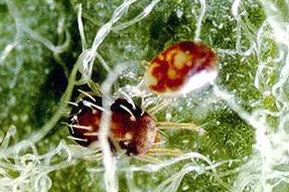
 November 11, 2009,
November 11, 2009,
University Park, PA – The control of spider mites is being biologically
controlled in Pennsylvania apple orchards with two tiny insects known to be
natural predators, according to Penn State researchers.
November 11, 2009,
University Park, PA – The control of spider mites is being biologically
controlled in Pennsylvania apple orchards with two tiny insects known to be
natural predators, according to Penn State researchers.
“Spider mites feed on the
chlorophyll in the cells of leaves, damaging their ability to use
photosynthesis,” said David Biddinger, tree fruit entomologist and biocontrol
specialist at the Penn State Fruit Research and Extension Center in
Biglerville. “When the numbers of mites per leaf reaches 25 to 30, the tree
becomes stressed and the leaves start to bronze. This affects the quality of
its fruit and in two to three seasons can actually kill small trees.”
 |
|
| Spider mites |
The two most popular
insect specialists used to control spider mites are a ladybug named Stethorus
punctum and a predatory mite named T. pyri. These insects prey on two types of
spider mites, the European red mites and the two-spotted spider mites, which
are agricultural pests worldwide. Much of Biddinger’s work is in Pennsylvania
apple orchards, a prime target for both types of pest mites.
Although the ladybug and
the predatory mite both hunt spider mites, their ways of tracking them down are
different.
“It turns out the
predatory mite sort of roams around and bumps into them,” said Biddinger. “The
ladybug, on the other hand, is a selective killer, hunting using visual and
olfactory cues to prey on spider mites.”
The ladybug is tiny, oval
and black and is a natural killer of pest mites. It is attracted to specific
volatile chemical signals given off by the damage the spider mites cause to
leaves. It is not just the smell that drives the ladybugs wild; this insect
cannot resist the yellowing of the leaves damaged by spider mites. Adult
ladybugs can live for over a year and eat up to nine mites an hour or 75 to 100
a day.
The predatory mite is much
smaller than the ladybug. It is pear-shaped and is usually creamy-white in
colour. Young mites develop into adults in a very short time, and their voracious
appetites make them a formidable enemy to spider mites. Adults have a lifespan
of about 75 days and can eat 350 mites during this time.
Reducing pest mite numbers
and controlling outbreaks with the aid of mite predators is an important task.
The biological control of spider mites reduces the need for mite-controlling
chemicals and saves growers millions in integrated pest management costs.
“Biological control is
basically using the good bugs to control the bad bugs,” said Biddinger.
Growers chose ladybugs as
their biological control agent until U.S. Environmental Protection Agency
regulations prompted growers to switch to new pesticides that kill ladybugs.
The predatory mite, however, was resistant and could live through sprayings. So
predatory mites are now the hunter of choice for spider mites.
Biddinger, working with
Donald C. Weber, research entomologist, U.S. Department of Agriculture,
Agricultural Research Service Invasive Insect Biocontrol and Behavior
Laboratory, Maryland, and Larry Hull, professor of entomology, Penn State,
published their work in a special issue of Biological Control devoted to
ladybugs in agriculture.
“With the pesticides we
are using now it is very hard for the ladybug to survive,” said Biddinger. “The
predatory mite could never exist here before because they could not stand the
old pesticides, but they are resistant to the new pesticides. With the
predatory mite being more effective than the ladybug, we are probably going to
exceed the savings for growers that we had with the ladybug in the past. So far
we have reduced miticide use by over 90 per cent since we switched. This is
saving growers about a million dollars a year and is reducing oil spraying by
45,000 gallons a year.”
Print this page